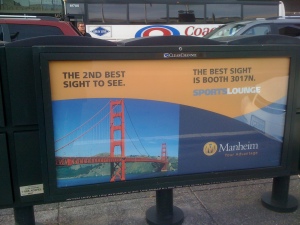I recently returned from the National Automobile Dealers Association (NADA) trade show in San Francisco for our client Manheim. We repurposed last year’s “sports lounge” booth, enhancing a few key elements. Why would we want to use the same sports lounge concept from last year? Well, it worked. How do we know it worked? We looked at the results.
We didn’t just look at anecdotal comments from industry leaders such as Kathy Jackson of Automotive News, who stated in her blog, “They really had it going on at the Manheim booth – sports bar with lots of flat screen TVs and free beer, wine, soft drinks and nuts. You would have thought you were on the set of ‘Cheers.’ The bar was packed.” We also looked at last year’s results, such as 800 unique attendees engaged at the booth for an average of 28 minutes per person.

So going into planning for this year’s trade show, the consensus was to go with what worked last year and aim to make it even better. The primary goals were to increase the number of attendee engagements as well as time spent with the attendees.
First, we increased the size of the booth footprint, making the sports lounge 10 feet deeper. Since the sports lounge was packed last year, we figured attendees may appreciate more seating and more elbow room. And, oh yeah, we may be able to engage with even more attendees.
 Second, we promoted the sports lounge with news racks near the trade show and pre-show e-blasts to dealers, promoting an NFL replica football giveaway.
Second, we promoted the sports lounge with news racks near the trade show and pre-show e-blasts to dealers, promoting an NFL replica football giveaway.
Third, we secured and branded a nearby sports bar with 31 interior and exterior window banners, two continuously looped, closed-circuit television spots, napkins and cups. We invited attendees to join Manheim and watch the “Big Game” between the Green Bay Packers and Pittsburgh Steelers on February 6th after the trade show. There, we gave away more footballs, iPod touches and iPads.
and Pittsburgh Steelers on February 6th after the trade show. There, we gave away more footballs, iPod touches and iPads.
The results:
- An increase in unique engagements over last year, from 800 to 1,150.
- An increase in average time spent in-booth with attendees, from 28 minutes to 32 minutes.
- Engagement with more than 350 attendees for an average of THREE-PLUS hours at the off-site sports bar.
So what does it all mean? First, by establishing measurement criteria up front and looking at results, you can evaluate program-to-program performance objectively. Second, even if previous results were good, they can always be better. Third, you may not need to reinvent the wheel to drive results. And finally, people like free beer and sports.
Gary Sayers, Vice President, Account Director





